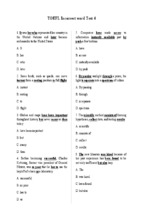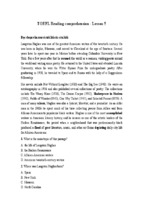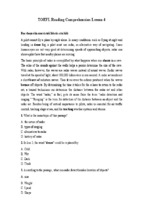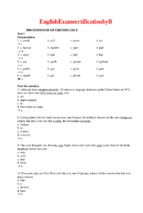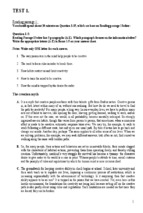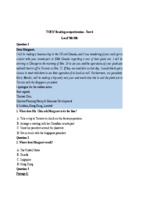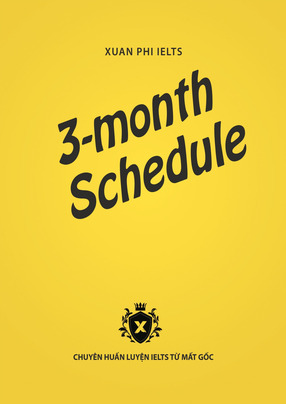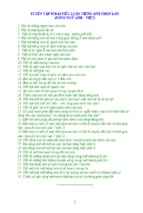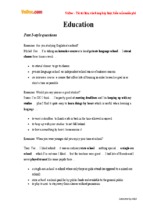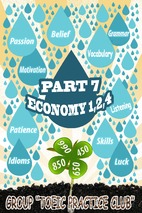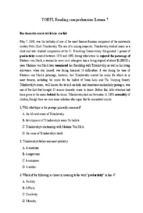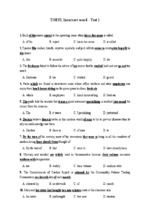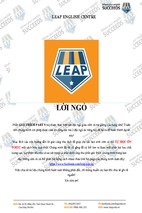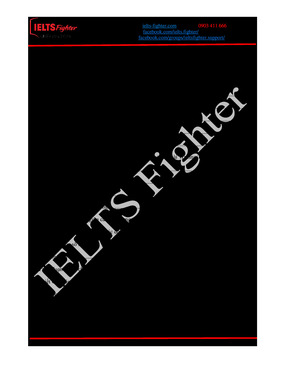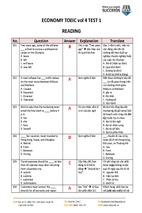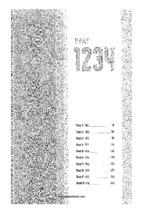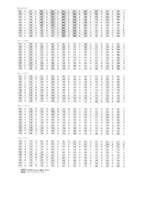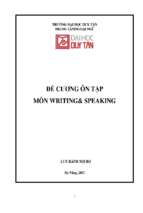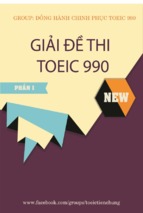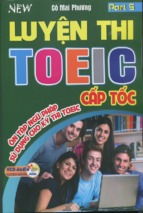-
-
--',' ... :
..
-
_. ._. - ..
....
---...... .....
,
..
.
•
-
.
.', .
I
-- .
•
I
--~
~
;
IELTS Reading Tests .
,
,,I
Reading Tests
,
I
I
!
I
I
I
I
I
I,
MCCarter & Ash
,I
.
..
"
. . . ':
.
.
.
..;
.~--~,~,~--
____..__._ _ __ _ _ _ _ _ _ __
---
1...J....
r·
IntelliGene
Published by Intell iGene 2001
ISBN 0951 9582 4 0
Copyright Sam McCaner and Judith Ash.
The contents of this book in no way reflect the views of the authors.
No material from this publication may be reproduced without the express pennission of the authors.
I
'.
'r,... ,;,4- .McCarter and Ash, IELTS Reading Tests
..;.;. '!')!'.)mi ..J~1:,> .J)(J olr..!.;b » .I...a.) ~1)L::.;1 :~t; ,~
o· .. :j1d .\rAr .h!~
o~ w~le>
,t..a.) &~,,i • nn..\,\f :~ ,ff \ff·f - ft · ·'\rY :~ • "" • ..5~ .0..... )l.I.;j .
•l.a)ykS' .~w .r·"'f\·r:~. A...5~ 'u!f'!-lf-~4b ~~ 0~~ ,.)~1..::..,)L....
,.. . O·\(),v:.}t .oJ.ij,) ;t...~ J* .~b· j,ia...
J~)
T'I'. • •
:.:..J
IE LTS
Reading Tests
,
·
· ,I
Contents
,,
i
Page
Reading Test 1 .... ... ...................... ........ ..... ........ ................. .... .... .. ..... .......... .. ... ....... 13
Reading Test 2 ......... .. .............. ............. .... ...... ... ................................... .... .. .......... .. 23
· I
Reading Test 3 .......... :........................ .. .. ....... .. ....................................... ...... ........... 33
Reading Test 4 ............................. .. ...... ...... ... ........ .. .. ....... ....................................... 43
Reading Test 5 ............ ... ...... ................................................ .... ............. .. .... .. .......... 53
Reading Test 6 ..... ... .. ............. ... .. ............................................... ............................. 63
Reading Test 7 ................... ....................................................... .............................. 73
Reading Test 8 .......... ...... .. .. ..................... ................ .................. ...... .. ..................... 83
Reading Test 9 ............. ........................................................................................... 93
· 1
·
;
Reading Test 10 .................... ...................... ............................................. :...... ...... 103
Key ................................................................. .. .. ... .. ... .................... .. .................... 115
Appendix ...... ............. ............. .... .......... ..... :..... ... ......... ................. .... ... ...... ..... ...... 146
·,
I
· I
o S;un McCarter & Judith Ash
3
I:
-~~~~-------------------------r
IElTS
Reading 1em
Acknowledgements
The authors would like to thank the following colleagues and friends for their help and support during the writing and
production of this pUblication:
Hilary Finch, Inna Shah and Roger Townsend.
We would like to thank The British Library for pemrission to reproduce the extracts which appear in Reading Passage
1 in Test 7 and Reading Passage 1 in Test 8.
1
,
All of the other articles j[l this publication were sp«:cially commissioned for this publication and we would like to thank
the following writers for the ir contributi"ons:
1
I
Beatrice Bame, Beata Bart, Anthony Brown, Dr Susan Beckerleg, Lis Bisranne, Margo Blythman, Samantha Carter,
Dr Charles Chandler, Sandra Chandra, Barry Deedes, Beryl Dunne, Doug Foot, John Goldfi nch, Peter Hopes, Dr
Stepan Kuznetzov, Ruth Midgley, Sarah Moore, James Nunn, Polly Rye, Professor Mike Riley. Wendy Riley, Micky
Silver, Dr Maureen Sorrel. Myrna Span, Dr Dave Tench. Areema Weake and Doug Young,
We would also like to thank the Cambridge Local Examinations Syndicate for permission to reproduce the Reading
Answer Sheet in the Appen~lix,
We would also like to say a very special thank you to Drs Gill and Bruce Haddock for another sterling piece of work.
' .
, .'
"
4
(> Sam MeCartef
& Judi th Alh
------------''--.-.,....
--~
IELTS Reading Tests
About the Authors
Sam McCarter is a lecturer in academic and medical English at Soulhwark College. where he organises IELTS courses
for overseas doctors and other health personnel, and courses in medical English, including preparation for the OSeE
component of the PLAB.
Sam McCarter is also the creator and organiser of the Nuffield S.elf-access Language Project for Overseas Doctors and
is a free- lance consultant in medical English, specialising in tropical medicine.
Sam McCarter is co-author of A book for IELTS, the author of a book on writing, 'BPP Englisb for PLAB and
Nuffield Stress Tests for PLAB . He has also co-authored several other publications and edited a fange of health
publications.
Judith Ash is a former lecturer in academic and medical English at Southwark College. She now writes freelance and
is working on distance learning programmes for tELTS and a series of tELTS books.
Judith Ash is co-author of A book for fELTS.
Future Publications by IntelliGene:
IntelliGene will be publishing a series of practice books for IELTS by Sam McCarter and Judith Ash. The next
books in the series will be on writing and listening.
!
- I
[W O
IntelliGene will be publishing a major book on communication skills in medicine by Sam McCarter and a new book on
writing skills.
,
,
-I.. I~
I
I
'
..
',,"-'"'-".~"'~-~~~~~-~-----------------------'-,
IELTS
Reading Tesis
Preface
This book is for ·students preparing for the Reading Test in the Academic Module of the International English Language
Testing System (IELTS), which is administered by the British Council. the University of Cambridge Local Ex.aminations
Syndicate (UCLES) and IELTS Australia.
The book contains ten practice Reading Tests and a Key. Each Test contains three reading passages, which cover a
variety of topics and give lots of practice for the range of question types used in the LELTS exam.
All the articles in mis publication except for two were specially commissioned.
The book may be used as a supplement toA Book/or IELTS by McCarter, Easton & Ash, as a supplement to a course
book or for self-study.
So that you may repeat the ex.ercises in this.book, we would advise you to avoid marking [he [ext.
Sam McCarter and Judith Ash
October 2000
..
6
'
.
o Sam McCarter & Judith Ash
IELTS Reading Tells
The IELTS Academic Reading Madule
The Reading Test jl} the TELTS exam lasts for 60 minutes.
-,
The test contains three reading passages, which may include pictures. graphs. tables or diagrams. The reading passages
are of different length, ranging from approximately 500 to 1.000 words. The total for the three passages is between
J ,500 and 2,500 words. Each reading passage has several different types of questions, which may be printed either
before or after the passage. Often the texts and the questions become more difficult as you read from Passage 1 to 3.
Reading Instructions
'Cl
You should always read the instructions for each section in the reading lest. The word limit. for example, in a sentence
completion exercise may vary from exercise to exercise. In a heading matching exercise, you may be able to use
headings more than once. So be careful!
o
Timing
Candidates often achieve a lower score than expected in mis component of the IELTS exam, because they spend too
much lime on some sections and do not finish the test. It is very important to attempt to fin ish the test. You will not have
time to read and enjoy the passages: instead. you should learn to work oul what the question you are doing requires and
find each answer as quickly as possible.
For many students timing is a problem. They find it difficult t6 leave a question that they cannot answer. This is
understandable. but in the IELTS it is disastrous. While you are not answering a difficult question you could be answering
two or three, or even more, easier ones. Then you can come back to those you have left blank afterwards.
II Topics
The reading passage topics vary, but are all of an-academic nature. Candidates sometimes panic when they are faced
with a reading passage on a subject about which they know nothing at all. It is important to remember that the answers
to all of the questions 8re in the text itself. You do not need any knowledge of the topic to be able to answer the
questions. The test is designed to test your reading comprehension skills, not your knowledge of any particular subject.
" Answer sheets
You must complete the answer sheet within 60 minutes. You will not have extra time to transfer your answers from the
question paper to your answer sheet. Candidates often think that, because they have time to transfer their answers in the
listening section. the same thing happens in the reading section. It does not .
., Question type
You may have to answer any of the following question types:
Matching the two parts of split sentences
In Ihis type of exercise, you are asked to match the two parts of split sentences. The main point here is that the
completed sentence summarises the information in the reading passage. The sentence will most likely be a paraphrase
of the text, so you will have to look for synonyms of the statement in the exercise.
Make sure the grammar of the two parts fits.
o Sam McCarter &; ILKlilh Ash
7
"
--'-'--
...
.
IELTS
Reliding Tests
The completion of sentences, summaries, diagrams, tables, flow charts, notes
In this type of exercise, you are asked to complete sentences or text by using a limited number of words taken froin the
passage. Finding the answers is simply a matter of scanning a text for specific information. This type of question is
normally used to see if you can recognise particular poims of information. Note the text in the exercise, as in the other
question types. may be a paraphrase of the language in the reading passage. So you should not always be looking in the
passage for the same words in the stem of the sentence, but the idea expressed in another way.
You should always check what the wo rd limit is: it may be one, two, three or four words. Reme mber also to make sure
the words you choose fit the grammar of the sentences.
Short answers to open qnestions
This type of exercise is very similar to the previous one. This is simply a matter of scanning the text for specific detail.
Again always check the word limit.
Multiple Choice Questions
In Multiple Choice Questions or MCQs, you are asked to choose the correct answer from four alternatives ABeD.
Among the four alternatives ABeD, you will obviously have an alternative which is the correct answer. The other three
alternatives can controdict the information in the passage either by staling the opposite or by giving information which
although not the opposite. still contradicts the original text. For example, the reading passage may S£8.te that there are
ren houses in a village and an MCQ alternative may say twenty. The information is obviously nOt the opposite of what
is in the text. ItcontradiclS the original text, because the information about the number is given. but it is not the same.
It is interesting that studen~ can usually see this clearly in MCQ type qUe5tions. but not when it comes to YeslNo/NOl
Given statements. See below.
The alternatives can also give information which does not appear in the text or information that appears in the te,;.t, but
in a different contex.t
Note that if two alternatives have £he snme meaning, but are expressed in different ways, neither will be the correct
answer.
Different ways to approach MCQs
o
exclude the alternatives which you th ink are wrong so that you end up with only one possibility.
o
read the stem before you read the alternatives and decide on the answer, i.e. If the stem gives you enough information.
Then read the alternatives and see if you can find one to match your own answer.
o
cover the alternatives with a piece of paper, so that you can see only the stem. Then, you can reveal the alternatives
one by one. [n this way, you will become less confused. Part of the problem with MCQs is the fact that you see all
the information at once and it is difficult to isolate your thoughts, especially under pressure.
YeslNolNot Given statements
In Ye~oINot Given exercises, you have to a~alyse the passage by ~tating.~ helher the information given in a series of .
statements is C.orreet, contradictory, or if there is no infonnation about the statement in the passage.
8
..
C Sam McCarter &; Judith Alb
'
IELTS Reading Te,t,
Students find this type of question difficult. Here are some specific hints to help you:
(!)
QJ
Read the whole statement carefully before you make a decision.
Look at the information in the whole statement, not part of it. For example , in the following • 'he'Infanna "Ion given
.
in the exercise statement is Yes as regards the text.
Text:
There was a rapid increase in motorbike sales iover the period j
sales rose over the period.
Exercise: \~otorbik~
Note that the text gives m?cc information than is being asked about in the exercise. The exercise is just checking about
whether the motorbike sales increased.
® Make sure you use the question to analyse the text and not vice versa. Look at the following:
Text:
Motorbike sales rose over the period.
E xercise: There was a rapid increase in motorbike Sales.
You can now see thllt !he answer is Not G iven. We do not know what the rate of increase was!
Cl Make sure you understand the three types of contradiction. Look at the foliowing:
There was a rapid increase in motorbike sales over the period.
Text:
Exercise: Motorbike sales did not rise rapidly over the period.
The ansy{er here is obviou51y No. The contradiction in the negative is clear.
Now look at the following:
There was a rapid increase in motorbike sales over the period.
Text:
Exercise: Motorbike sales rose slowly over the period.
In this case you can see that the answer is No. The word slowly contradicts the word rapid.
There is, however, another type of contradiction. which students quite often confuse with Not G iven.
Text: 1\vo ty pes of earthworms were used to create a soil structure
Exercise: There were three types of worm used in creating a soil structure.
The answer is obviously No. The information about the number of worms is given clearly in the text, but the
number in the exercise is different. Even though they are not opposites, they stilt' contradict each other!
Gap-filling exercises
There are ba5ically two types of gap-filling exercise:
a summary of the text or part of the text with a number of blank spaces, which you complete with a word or phrase
from a word list.
a summary with a number of blank spaces without a word list, which you complete with words or phrases from the
reading passage.
There are different techniques for doing this type of exercise and you may have some of your own which suit you very
well. One simple aid is to read the summary through quickly to get the overall idea of the text. Then think of what kind
of word you need for each blank space: an adjective, a noun, a verb, etc .
e Sam McCarter & Judith Asb
9
,-'------
'-,--.
-
.....
IELTS Reading Teds
Think of your own words that will complet.e the meaning of the text if you can, so that when you look at the ~ding
passage or word list. you will be able to recognise a synonym quicker.
Matching paragraph headings
In this type of ex~ rci se yo u are asked to match a heading to a paragraph. Many students find this type of question
difficult. The following techniques may help you:
a
o
Avoid reading the first and last scntenceofa paragraph to give you the heading. This does not work in many cases.
II depends on the paragraph type. For further information, see Exercises I - 12 inA bookfor IELTS by McCarter.
Easton & AS!I.
Read each paragraph very quickly, thcn look away from it briefly. Decide what the main idea of the text is. If you
try to read and decide at the same time, it only confuses you.
a
a
a
a
Ask yourself why the writer wrote the paragraph. This may help you to exclude a heading wnich relates to minor
information. nnd which is intended to distract you.
Ask yourself if you cun put all thc infonnation in the paragrapn under the heading you have chosen.
Check whether the hel.lding is made up of words which are just lifted fro m the text. This may just be a distractor.
Lenm to distinguish between theji)CI/,\' of the paragroph nnd the subsidiary or background information, which is
used to support the fOCllS. Look at thl! following paragraph for example:
It is a myth that creative people are born with their talents: gifts from God or nature. Creative
genius is, in fact, latent within many of us, without our realising. But how far do we need to
travel to find the path to creativity? For many people, a long way. In our everyday lives, we
have to perform many acts out of habit to survive, like opening the door, shaving, getting
dressed, walking to work, and so on. If this were not the case, we would, in all probability,
become mentally unhinged. So strongly ingrained are our habits, though this varies from person
to person, that, sometimes. when a conscious effort is made 10 be creative, automatic response
takes over. We may try, for example, 10 walk to work following a different route, but end up on
our usual path. By then it is too late to go back and change our minds. Another day, perhaps.
The same applies to all other areas of our lives. When we are solving problems, for example,
we may seek different answers, but, often as not, find ourselves walking along the same welltrodden paths,
The text in halics above is background or .~I//,sidi(ITy information. If you ask yourself why the writer wrote the paragraph,
you wou ld not answer that he wrote it to talk about our daily habits or the habits we need to survive. He is using the
example of daily habit.~· to i!Jllstratc how they limit (Jur creativity. So YOIl can see that any heading for the paragraph
needs to combine two elements. namely: the limiting of creativity and the elements which set the limits . Of the two
pieces of infoonation the former is the more important of the two! Note that you should not be persuaded by the amount
of lext devoted to the habits . . '.
_.
Try this approach with any paragraph you read. In the beginning. it will" slow you down. However. gradually you will
leDm the relationship between the various pieces of information.
o
Learn to recognise different types of paragraphs. When people are reading a text fo~ the fteSt time they think that
they know nothing about it. Howe.ver. you should approach a reading passage by saying to yourself that you are
aware of the overall structure of the artic le and you are prob,",.-\.... _;'....
.:.,~~,.\ ... ,". ;'.,.
l··.~···
'. :/~:~"~._ ....,,:} :;~':;.,> -';'
.,,~._ ..
':me problem of.pbysical access to buildings has now ~e.n ~~29": ~11 ' "by'" tech"hology:Mes; ages are
.
•
' .
.,', '_-I",. ,'.
,,"
','
•
sent between
21_~, with passwordsnot.allowing ~~·to read'someoneelse's messaoes.
.
. , ' ,-,
.
'
'. .
" .
.,
"',"
But. while individuals are becoming increasingly _ _~3_ _ . soc j ~lI y. ~y ~ e "~ay they do theirjob. at .
"' .-,
.~ ..
.
.
the same time more value is being put on ~"__24 _ _. f'low«;yer. e:'n:tail a'ryd voice-ma'i} have led to a
-.
"
.,'"
,:.,~",~~" 25+
.
', ' , .
". .. .
,',.'.
",'.',
",.,
"1-":j",) , ', , '
.....
~pp~rtunities,. ror ~~~9?~t?-~~SO~, c~rp~~~nk~~io~: ~P~~+,~~la.~~ ,~,h,a~j.?? .sbc~rity, is
.'generalry· not raV3iiable nowadays-is hldd"en by the very concept:of ,'. ". 26r":'~~~~-Humiul~f~source~ are
,
.,
~
,f.·
"~
1, ' •• '"... - ' •
now regarded in . . 27,
' l ' . ,-- , '" .. . •
•
"
~~
I,
' phYSIcal ones. · ,"
,.
"
.. , , -
.
f
"
" -._ . . . ,,,
,
....
.
~.,
!,"i
- -•.
,.:,,)
. . ..... "...
.,.Jl ..... '!fi:
\-' ~.' .. r~.'
i{'<'.~;,,',
!.' ~'~"
....'.~,~.;~~~
~:,.
' that 'dining oul ' is simply 'action which supports a surface life'. For him it is the word
'om' that disconnect<; food from culture. This view of culture and food places the 'home' as the cultural
centre. COLHinental Eu ropean eating habits m.lY contradict this notion 'by their general acceptance of eating
out as pan of family life. Following the principle that culture needs behavioural reinforce ment, if everyone
'cats' ont' on a regular basis, irrespecti ve of soc ial and economic .differentiation, then this might constitute
behavioural support for cuisine being patt of social culture. That aside, the significance of a behavioural
practice being embedded in cultu're is that it naturally maint.1ins an approved and accepted way of life and
therefore has a tendency to resist change.
The thrust of the argument is that countries differ in the degree to which their food and eating habits have a
socinl and cultural meaning beyond the behaviour itself. This argument, however, could be interpreted to
imply that the country with the grcntest proportion of meaL<; taken Olltside the home would be the one in
which the national cuisine is more embedded in social cu lture. This is a difficuJ.t pOSition to main tain because
it would bring America, with its fast-food culture to the rore. The fast-food culture of America raises the
issue of whether there are qualitative criteria for the concept of cuisine. The key issue is not the extent of the
comlllon behavi.our but whether or not it has a function in maintaining social cohesion and is appreciated
20
C Sam McCarter &. Judith Ash
I
- Xem thêm -

